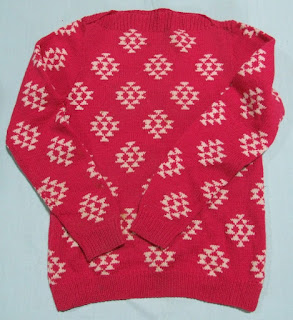I recognised it because I saw that sweater in 2012. It was designed by Elizabeth Forster, and the sweater was one of those I saw when I visited the house in Norfolk where she had lived, as I described here.
I am used to matching knits to the patterns that they were knitted from, but this one is the other way round: it is the sample knit that Elizabeth Forster sent to Woman magazine with the design, and so is the exact same sweater that the model is wearing in the photo. If I hadn't already seen the sweater , I wouldn't have known that it was one of her designs - there is nothing in the Woman supplement to identify any of the designers.
Spotting this design as one of Elizabeth Forster's prompted me to look again to see if I could find any more of her designs. She kept extensive paperwork on the designs that she sold, and I took photos of a few examples when I was in Norfolk. If she sold a design to a magazine, the company whose yarn she specified also paid a 'placing fee' (as well as providing the yarn to knit the sample I believe). Her invoice specified the date of the magazine, with a very brief description of the garment. So for instance, in an invoice sent to Emu Wools in 1959, is an item
"To yellow calypso blouse in Woman's Own supplement 7.3.59 .... £3. 3s. 0d"We have that knitting supplement from Woman's Own in the KCG collection, and here is the yellow blouse in Emu Calypso:
 |
| From Woman's Own supplement 'Knitting for Out of Doors", 7th March 1959. |
The pattern is headed "Sun Bright . . . Fashion Right" and goes on "An attractive belted blouse in stocking stitch". Evidently Calypso was a fine yarn: the blouse is knitted on size 12 and 13 needles (2.75mm and 2.25 mm), to a tension of 9 stitches and 12 rows to 1 inch. (About 36 stitches and 48 rows to 10cm.). It's a neat, tailored, knit and very elegant, but would anyone want to put in so much work now?
I found a few more of Elizabeth Forster's designs, by matching invoices for placing fees to Woman's Own supplements we have in the collection. This one is headed "Long, Loose and Elegant".
 |
| From Woman's Own supplement "Family Knitting", 1st October 1958. |
The description goes on: "This lovely middy style jersey pinpoints today's feeling for long, straight lines. It is worked in stocking stitch with a deep moss stitch collar." (That's 'middy' as in midshipman, which came to mean "A woman's or child's loose blouse with a sailor collar") It's knitted in Patons Beehive Fingering 4-ply, also on size 12 and 13 needles, to a tension of 8 stitches to the inch.
Another design from 1960 is in slightly thicker wool, Patons Quickerknit Botany. Again a lot of stocking stitch (at 7 stitches to the inch) but with a leaf motif at the neck.
 |
| From Woman's Own 'Knitting for All the Family' supplement, 20th February 1960. |
These are all good-looking knits, but it's daunting to think of the time it would take to knit all that stocking stitch - even the thickest yarn used is finer than DK. But I suppose that knitters in the late 1950s were used to that - and these designs are overall much more interesting and stylish than the very plain boring stocking stitch twin-sets which also appeared in knitting patterns at that time.
As I've said before, it's sad that the designers of knitting patterns were rarely acknowledged - if Elizabeth Forster had not carefully kept all her papers, I doubt if it would be possible to identify these three designs as her work. I'm very pleased to have been able to use the paperwork and the KCG collection to make the link.
Elizabeth Forster carried on designing knitwear through the 1960s and 1970s, and many of her later designs were influenced by her travels around the world, and her interest in bird-watching. Her archive of papers and sample knits is now under the care of Norwich Castle Museum. There was a fascinating exhibition of her work at the museum in 2014, including designs featuring birds and othes showing a South American influence - you can see my photos of the exhibition here.


Great detective work. It would be so nice to know more often who did the designing of the patterns.
ReplyDeleteDear Barbara, I contacted you some time ago regarding an Elizabeth Forster design, hand-knitted by my mother in 1960. Well, here it is at its new home at the textile department of Norwich Museum. Ta-da! The Adam Faith sweater:
ReplyDeletehttps://youtu.be/pkrihcLsRNE
Sorry, I can't get the hang of proper links. But I wanted you to know that, thanks to your blog, the old fella has been resurrected and is now a vintage exhibit. How time flies. I am so pleased I hung on to the sweater even when I stopped wearing it. I couldn't bring myself to give it away or chuck it out as so much of my late mother's love went into the knitting of it.
Thanks very much for the link - I hadn't realised that your donation of the Adam Faith sweater came about from reading my blog. I feel very proud! And so pleased it's found a good home with the Elizabeth Forster archive.
Delete